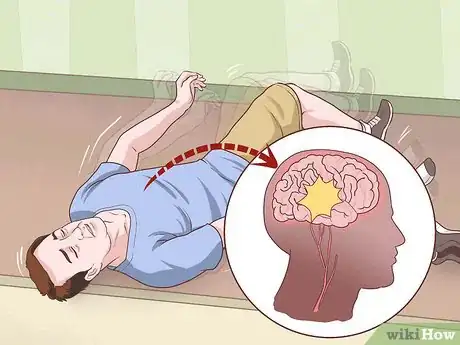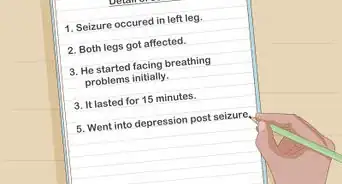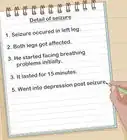This article was co-authored by Chris M. Matsko, MD. Dr. Chris M. Matsko is a retired physician based in Pittsburgh, Pennsylvania. With over 25 years of medical research experience, Dr. Matsko was awarded the Pittsburgh Cornell University Leadership Award for Excellence. He holds a BS in Nutritional Science from Cornell University and an MD from the Temple University School of Medicine in 2007. Dr. Matsko earned a Research Writing Certification from the American Medical Writers Association (AMWA) in 2016 and a Medical Writing & Editing Certification from the University of Chicago in 2017.
There are 11 references cited in this article, which can be found at the bottom of the page.
This article has been viewed 21,029 times.
Frontal lobe seizures are a part of a group of seizures called focal or partial seizures because they only affect a part of the brain.[1] This type of seizure can be mistaken for other disorders, such as night terrors or even a psychological disorder.[2] Usually, the best methods of diagnosis include brain scans and MRIs to see abnormal activity, but you can look for signs and symptoms at home.
Steps
Recognizing the Symptoms
-
1Look for odd body poses. That is, seizures can cause a person to move in funny ways. For instance, you might see one arm stick straight out for no reason while the other one stays close to the body.
-
2Pay attention to repetitive motions. This type of seizure, as with most seizures, can cause a person to move in a repetitive way. For instance, the arm might flex repeatedly, or the hips may thrust into the air. The person may rock back and forth or bicycle their legs. These kinds of movements, in coordination with the person being unresponsive to you, can indicate a seizure.
- These types of seizures can also cause muscle weakness.
Advertisement -
3Look for facial contortions. Because the frontal lobe controls movement, it can lead to strange contortions in the person's body, including her face. You may notice strange eye movement or the person making strange faces. For instance, the person may blink too much, twitch, or make chewing or swallowing motions.
-
4Talk to the person. Ask the person a question. If the person can't talk to you or doesn't even seem to notice you are there, she may be having a seizure.
- However, not every seizure causes a person to be unresponsive. Sometimes, the person will stay conscious through the whole seizure.
-
5Check for them while sleeping. Often, frontal lobe seizures happen at night, when the person is sleeping. If you see the symptoms above when the person is sleeping, she might be having a seizure. Similarly, if you wake up suddenly with tense muscles or in an odd position, it could mean you've had a seizure, though it could also mean you had a bad dream.[3]
-
6Note the time. These type of seizures are often very short. In fact, most of the time, they last less than a minute. Keep an eye on the clock if you notice someone with these symptoms to see how long it lasts.[4]
-
7Watch for cluster seizures. Cluster seizures, or short bursts of seizures, sometimes occur with frontal lobe seizures. If you have several seizures in a row, it could be a symptom.
- If the person doesn't regain consciousness between seizures, she should be taken to a doctor, or you should call 911.
-
8Understand what causes seizures. Seizures often arise after trauma to the brain. However, other conditions can lead to seizures, as well, such as strokes, infections, or even tumors. Many conditions that cause an issue in your brain can lead to seizures.[5]
- Nonetheless, many people have nothing else wrong with their brains and still develop seizures.
Going to the Doctor
-
1Write down your symptoms. If no one has observed you having a seizure, write down what you do experience. Maybe you notice you lose bits of time, or find yourself waking up in the middle of the night with sore muscles. Whatever symptoms you are experiencing, even if you think they aren't related, could be important.[6]
-
2Tell the doctor about your symptoms. Make sure you bring up all your symptoms with your doctor. For instance, even random mood swings or strange sensations can be related to seizures. It's also important that you provide the doctor with information about the timing of the symptoms, as frontal lobe seizures often happen at night. Symptoms you may notice in yourself or others include:
- Losing time.
- Waking in odd positions.
- Having sore muscles with no other explanation.
- Mood swings.
- Body contortions.
- Unconsciousness.
- Seizures while sleeping.
- Repetitive facial movements such as twitching or chewing motions.
- Several seizures in a row.
- Odd body positions (such as one arm out).
-
3Provide a complete medical history. A complete medical history is necessary in order to determine the cause of the seizures. While these types of seizures do not always have a cause, they can be caused by head trauma, stroke, mental health, medications, or other brain abnormalities.[7]
-
4Go to the emergency room. If someone has a seizure that lasts more than 5 minutes, you should take that person to the emergency room. Call 911 if you've been watching the clock while someone was seizing or even if you feel like the seizure has gone on too long but you didn't note the time.
Using Diagnostics
-
1Submit to blood tests. If you haven't been diagnosed with frontal lobe seizure, it is important to rule out other medical conditions. Seizures can be caused by other problems in the body, and blood tests will measure things like body chemistry and your blood sugar level.[8]
- A blood test is done by obtaining drawing a sample of blood from you, usually from a vein found at the inner aspect of your elbow. The sample is then brought to the laboratory for analysis.
- Patients with acute seizures should have blood tested for electrolytes, BUN, creatinine, glucose, calcium, magnesium, and liver function. Other tests should also be performed in anticipation of treatment, such as a complete blood count, differential, and platelets.
- Part of the test, called the complete blood count, will measure the number of white blood cells, the number of red blood cells, the amount of hemoglobin, and how much of your blood is composed of red blood cells.[9]
- The blood test should show normal values of electrolytes and other compounds that may affect brain function. For example, decreased levels of glucose and magnesium may lead to seizures.
-
2Be ready for an MRI. If your seizures start out of the blue, your doctor is going to want an MRI. An MRI will reveal if something else is going on with your brain, such as a tumor or lesions. It will also locate any unusual blood vessels. It is not a painful procedure.[10]
- This test is a combination of radio waves and strong magnets, used to create an image of the soft tissue in your brain. You will lay down on a bench and be pushed into a donut shaped machine where you will need to be still for a period of time. The test can take an hour but generally isn't longer than an hour and a half. The machine will make loud noises.[11]
- In some cases, the technician may inject an artificial dye into you to help create the image.
- You must remove any metal on your body before entering the machine, such as jewelry, hairpins, watches, hearing aids, and underwire bras; talk to your doctor about any devices in your body, such as a pacemaker or artificial heart valve.[12]
-
3Expect an electroencephalogram (EEG). This test measures the electrical activity in your brain, and it can show where the seizure is occurring. However, it really only gives your doctor information if she does the test while you're having a seizure. Even then, frontal lobe activity can be hard to detect. Your doctor may want you to stay overnight to detect seizure activity.[13]
- For this test, the technician will attach electrodes to your scalp. It is also a painless procedure.[14]
- On the day of the procedure, it's a good idea not to use any hair cream, styling gels, or spray, as it can keep the electrodes from sticking well.
-
4Know your liver and kidneys may also be checked. Often, your doctor will use blood or urine tests to check these organs. Mostly, these tests are done to rule out other problems that could lead to seizures.[15]
Warnings
- Side effects of anti-seizure medications may include drowsiness, dizziness, diplopia (double vision), and imbalance.⧼thumbs_response⧽
- Be aware that anti-seizure medications can cause hepatic enzyme induction and this can increase the metabolism of other medications.⧼thumbs_response⧽
References
- ↑ https://www.nlm.nih.gov/medlineplus/seizures.html
- ↑ https://www.sparrow.org/departments-conditions/conditions/frontal-lobe-seizures
- ↑ http://emedicine.medscape.com/article/1184076-overview
- ↑ http://emedicine.medscape.com/article/1184076-overview
- ↑ https://www.hopkinsmedicine.org/health/conditions-and-diseases/epilepsy/focal-epilepsy
- ↑ https://my.clevelandclinic.org/health/diseases/17011-frontal-lobe-epilepsy
- ↑ https://www.drugs.com/cg/frontal-lobe-seizures.html
- ↑ https://www.nlm.nih.gov/medlineplus/ency/article/000694.htm
- ↑ https://www.nlm.nih.gov/medlineplus/ency/article/003642.htm
- ↑ https://www.drugs.com/cg/frontal-lobe-seizures.html
- ↑ https://www.nlm.nih.gov/medlineplus/ency/article/003335.htm
- ↑ https://www.nlm.nih.gov/medlineplus/ency/article/003335.htm
- ↑ http://www.epilepsy.com/learn/types-epilepsy-syndromes/frontal-lobe-epilepsy
- ↑ https://www.nhs.uk/conditions/electroencephalogram/
- ↑ https://www.nlm.nih.gov/medlineplus/ency/article/000694.htm



































































Medical Disclaimer
The content of this article is not intended to be a substitute for professional medical advice, examination, diagnosis, or treatment. You should always contact your doctor or other qualified healthcare professional before starting, changing, or stopping any kind of health treatment.
Read More...